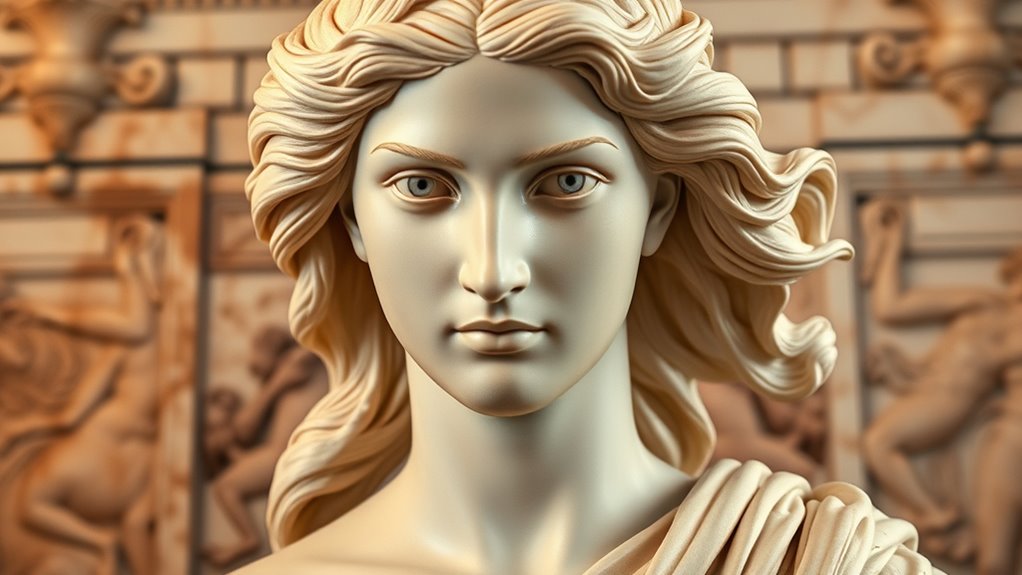Helen of Troy embodies divine beauty that sparks desire and conflict, symbolizing both power and fragility. Her story reflects how ancient propaganda and societal values shaped perceptions of morality and gender roles. As a political pawn or cultural icon, her image was used to justify wars and reinforce ideals. Exploring her complex symbolism reveals how beauty and storytelling influenced politics and society—if you want to understand how myth intertwines with history and power, you’ll find more fascinating insights ahead.
Key Takeaways
- Helen’s beauty symbolizes divine allure intertwined with destructive potential, reflecting both mythological symbolism and societal ideals.
- Her portrayal in art and literature conveys complex messages about desire, morality, and chaos across cultures.
- Historically, Helen has been used as political propaganda to justify wars, notably the Trojan War, blending myth with political motives.
- She embodies themes of power, vulnerability, and societal manipulation, illustrating how stories shape perceptions and narratives.
- Helen’s story highlights the interplay between myth and history, serving as a reflection of ancient worldview, propaganda, and cultural values.

Have you ever wondered why Helen of Troy’s name still echoes through history? Her story isn’t just about beauty; it’s a complex tapestry woven with mythological symbolism and layered with historical interpretations. From her legendary face launching a thousand ships to her role as a symbol of desire and chaos, Helen’s narrative invites you to see beyond mere appearance. In mythological symbolism, Helen often embodies the ideal of divine beauty intertwined with peril, illustrating how physical allure can ignite conflicts that reshape civilizations. She’s not just a woman caught in a love story; she’s a potent symbol of the destructive power of beauty and the fragility of human morality. Her story, rooted in myth, serves as a reflection of the Greek worldview—where gods and mortals are intertwined, and personal desires can have catastrophic consequences. To the ancients, Helen’s beauty was both a gift and a curse, a divine trait that could spark war, revealing how mythology uses symbolism to explore fundamental human truths. Additionally, her visual representation in art and sculpture highlights how her image was used to convey complex cultural messages across generations.
But your understanding isn’t complete without considering the historical interpretations that surround her figure. Many scholars see Helen as a political pawn, a tool used by ancient propagandists to justify war and diplomatic agendas. Some suggest her story was crafted to explain the Trojan War, framing it as a tragic consequence of a beauty contest among goddesses, _consequently_ blending myth with political motives. Others view her as a reflection of real historical figures whose reputations were manipulated and mythologized over centuries. In this light, Helen becomes more than a mythic symbol; she’s a mirror for how societies interpret and manipulate history to serve their narratives. Her story, _accordingly_, functions as a form of ancient propaganda, reinforcing cultural ideals, gender roles, and political power. When you examine her through this lens, Helen’s narrative transforms from a simple love story into a complex commentary on the human condition—how appearances can be deceiving, and how history is often shaped by those who control the stories that endure.
Ultimately, Helen of Troy remains a compelling figure because she embodies both mythological symbolism and historical interpretation. Her story continues to resonate because it encapsulates timeless themes: beauty’s power, human vulnerability, and the ways societies craft stories to explain their world. Recognizing these layers enriches your understanding and invites you to see her not just as a legendary woman, _and_ as a symbol of the enduring interplay between myth and history.
Frequently Asked Questions
How Did Helen of Troy Influence Greek Political Alliances?
You see, Helen of Troy’s story shaped Greek political alliances by becoming a powerful symbol of beauty and cultural ideals. Her role in the Trojan War influenced alliances between city-states, as they united or conflicted over her fate. Her image served as cultural symbolism, reinforcing shared values and identities. This way, Helen’s legend helped forge political bonds and fostered unity among the Greeks, impacting ancient diplomacy and social cohesion.
Are There Any Historical Records Confirming Helen’s Existence?
You wonder if any historical records confirm Helen’s existence. While some archaeological evidence and ancient texts mention her, there’s no definitive proof she was real. Most of what we understand comes from literary sources like Homer’s epics, which blend myth and history. So, you can’t be certain she’s a historical figure; much of her story remains part of myth and legend, not verified history.
What Are the Modern Interpretations of Helen’s Role in Mythology?
Modern interpretations of Helen’s role in mythology often see her through feminist reinterpretations, highlighting her agency and complex motives rather than just beauty. Artists and writers create new depictions that challenge traditional views, showing her as a symbol of choice and power. You can explore these artistic depictions and feminist ideas to understand how Helen’s story inspires discussions on gender, agency, and the impact of beauty in shaping myths today.
How Did Different Cultures Portray Helen of Troy?
You see that different cultures portray Helen of Troy through diverse lenses, shaping their unique perceptions. Artistic representations highlight her as a symbol of beauty, temptation, or even political power, reflecting cultural values. For example, Greek art emphasizes her divine allure, while later cultures may depict her more as a victim or a pawn. These varied portrayals influence how people interpret her role, blending mythology with cultural perceptions across time.
What Psychological Theories Explain Helen’s Legendary Beauty?
You might see Helen’s legendary beauty as rooted in psychological appeal and beauty perception, influenced by cultural standards and personal biases. Theories like the halo effect suggest her attractiveness enhances her overall desirability, while social comparison theory indicates her beauty sets a benchmark. These psychological concepts explain why her legendary beauty captivates minds, making her an enduring symbol of allure and aesthetic power across cultures.
Conclusion
As you reflect on Helen’s story, remember how her beauty was like a double-edged sword—capable of both inspiring admiration and igniting chaos. Think of her as a shimmering mirror that reveals society’s deepest desires and fears, yet also distorts reality. Just as a single glance can spark a war, her legend reminds you that beauty and agency are intertwined, shaping perceptions and history in ways that echo through the ages.









